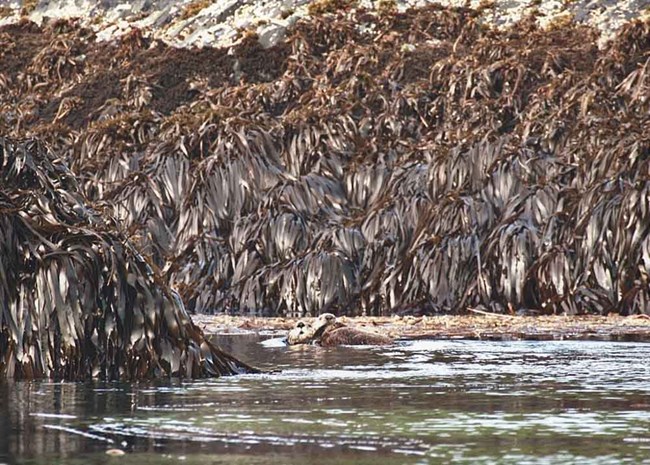Last updated: September 27, 2022
Article
Why did the southwest Alaska sea otter population collapse?

USFWS/Paul Schuette
The southwest Alaska stock of sea otters (Enhydra lutris) extends more than 1,553 miles (2,500 km) from Cook Inlet to Attu Island in the western Aleutian Archipelago. Throughout much of this range (Attu Island east to Castle Cape on the Alaska Peninsula), sea otter numbers declined by more than 90% between about 1990 and 2015. Due to the remoteness of this region, understanding cause(s) of the decline has been challenging. Could it be due to a lack of food? Could there be disease or contamination impacting the sea otters? Could something be preying on the sea otters?
To help answer these questions in a region that is difficult to access, but with the help of historical data, we examined a suite of metrics such as changes in the distribution, abundance and behavior of sea otters, changes in patterns in reproduction, mortality, body size and condition, diet and foraging behavior, food availability, health profiles, and exposure to environmental contaminants over the 25-year period. Our study design included comparisons before, during and following the decline. We also compared some of these metrics to other, stable or growing populations of sea otters to identify differences that might imply cause.
By looking at all the metrics together, we were able to deduce the likely cause of the decline. In the case of metrics indicative of the health of the sea otters (such as disease, contaminant exposure, or abnormal gene transcription patterns), we found no evidence that animals within the area of the decline were in poorer health than before the decline or with animals from outside of the declining population. Sea otters within the area of decline also had plenty of food to eat, were in good condition, and were reproducing at similar or even higher rates as before the decline. Based on the high reproductive rates, we knew that more sea otters dying (elevated mortality rates) was causing the decline rather than reduced reproduction, yet few carcasses were found, and in fact, the rate of carcass detection was lower during and after the decline as compared to before the decline when populations were stable.
What we did observe were changes to behavior over the course of the decline, such as the remaining sea otters moving closer to shore and into protected areas that would limit exposure to large marine predators such as killer whales or sharks. Based on these findings, we concluded that nutritional stress, disease, and contaminants are not likely drivers of the decline, but that there is substantial support for the hypothesis of increased predation on sea otters as the probable cause. Killer whales and large sharks are both known to depredate sea otters, although within the area of decline there are direct observations of killer whale predation but not of shark predation.
The ‘weight of evidence’ approach we use to evaluate support for competing hypotheses, based on multiple independent data types, provides a powerful means of understanding the causes of population declines in remote areas or difficult-to-study species. This approach could be broadly applicable to other wildlife populations where drivers of population status are unknown.
Sea otter population collapse in southwest Alaska: assessing ecological covariates, consequences, and causal factors
Abstract
Sea otter (Enhydra lutris) populations in southwest Alaska declined substantially between about 1990 and the most recent set of surveys in 2015. Here we report changes in the distribution and abundance of sea otters, and covarying patterns in reproduction, mortality, body size and condition, diet and foraging behavior, food availability, health profiles, and exposure to environmental contaminants over this 25-year period. The population decline, which resulted in densities on the order of 5% of environmental carrying capacity, ranged from Attu Island in the west to about Castle Cape (on the south side of the Alaska Peninsula) in the east. Remaining sea otters moved closer to shore and into shallow, protected habitats. Reproductive rates appeared unchanged with the decline. Although the demographic cause of the decline was clearly elevated mortality, stranded carcasses were rare or absent. The net rate of energy gain by foraging sea otters, body length and condition, and prey biomass density, all increased after the decline and varied inversely with sea otter population density beyond the area of decline. Sea otters within the area of decline showed no increases in health anomalies, disease, contaminant exposure, or abnormal gene transcription patterns as compared to animals outside the area of decline. These collective findings are inconsistent with nutritional limitation, disease, or environmental contaminants, and consistent with predation (or possibly some other density-independent factor) as the reason for the sea otter population decline. Our approach and analyses provide a broad conceptual template for thinking about and assessing the causes of wildlife population declines.
Tinker, M. T., J. L. Bodkin, L. Bowen, B. Ballachey, G. Bentall, A. Burdin, H. Coletti, G. Esslinger, B. B. Hatfield, M. C. Kenner, K. Kloecker, B. Konar, A. K. Miles, D. H. Monson, M. J. Murray, B. P. Weitzman, and J. A. Estes. 2021. Sea otter population collapse in southwest Alaska: Assessing ecological covariates, consequences, and causal factors. Ecological Monographs: e01472.
